Epiphone Les Paul Standard 60s Review. Is this the best affordable Les Paul you can buy?
Before we get into it, let look at the Epiphone Les Paul Standard 60s specs.
The Les Paul™ Standard 60s models from Epiphone’s new Inspired by Gibson™ Collection recreate the sound of 1960s era Les Pauls. Featuring a classic mahogany body with a maple cap, Grover® tuners, and powered by ProBucker™ humbuckers with CTS® potentiometers. Epiphone’s long friendship with Mr. Les Paul began in 1940 when Les built one of the world’s first solid body electric guitars while working nights at the original Epiphone factory in Manhattan. Les’ first solid body guitar, nicknamed “the Log”, would go on to inspire the Les Paul Standard, which many consider the greatest electric guitar ever made.
From Epiphone.com
Inspired by Gibson Epiphone Les Paul Comparisons.
The Epiphone ‘Inspired by Gibson’ Les Paul range has something for all tastes and wallets. Let’s compare them.
Epiphone Les Paul Junior
I’ve previously owned this guitar, the cheapest of the bunch, and despite it’s limitations still a fantastic guitar. Full review here
Check them out here.
Epiphone Les Paul Studio
Specs: Grover® Rotomatic machine heads , Coil tapping, Alnico Classic PRO™ humbuckers™, Ultra Modern weight relief, Slim taper neck. Speed knobs, RRP: £529.
This is the guitar that got me hooked on the idea of owning a Les Paul again. It immediately felt like I was playing my old Gibson Les Paul Studio, even possessing the same ebony and chrome vibe that made me part with my cash all those years ago. Looks like, feels like and plays like a Gibson, but I didn’t want to end my search here.
Epiphone Les Paul Classic
Specs: Grover® Rotomatic machine heads, Coil tapping and phase switching,“zebra” Alnico Classic PRO™ humbuckers, Slim taper neck. Gold with nickel insert knobs. RRP: £589
The option of the Honey Burst top, along with the more subtle brown back and sides makes this the best-looking of the new ‘Inspired by Gibson’ Epiphone Les Pauls. I was actually about to buy this but I was shopping for other things at the time, so asked the guy to hold it for me at the store. On my return I gave it one last try and noticed an uneven taper on the volume knobs. Maybe it was just this model but wasn’t prepared to take the risk. In hindsight would I really have used the extra switching options anyway?
Check them out here.
Epiphone Les Paul Standard 50s
Specs: Epiphone Vintage Deluxe 18:1 ratio machine heads, Epiphone ProBucker™ 1 & 2, Rounded Medium C neck. 50s style wiring, Gold Top Hat knobs with dial pointers. RRP: £679.
In comparison to the 60s Standard, this has a bigger neck, inferior tuners and lower output pickups. The two colour options, Heritage Cherry Sunburst and the Gold Top. aren’t as nice as the Iced Tea Sunburst of the 60s Standard.
Check them out here.
Epiphone Les Paul Custom
Specs: Grover® Rotomatic® 18:1 machine heads, Epiphone ProBucker™ 1 & 2, 60s SlimTaper™ neck, Gold hardware, All mahogany body, Custom split-diamond inlay on the headstock. RRP: £799
I’ve always felt that Les Paul Customs were a little too bling for me. and wasn’t prepared to pay the extra just for cosmetics, especially when the Standards look this good.
Check them out here
Why did I Buy the Epiphone Les Paul Standard 60s?
On paper, the Epiphone Les Paul Studio looks to be the no-brainer, particularly at that price-point, but it felt too much like deja vu and there’s no greater complement I can give Epiphone for that. I’ve actually owned two ebony Gibson Les Pauls, one my fantastic studio and my not-so-great Standard from even further back. Shallow I know, but I wanted a burst. As I explained earlier, I fell for the beautiful honey burst Classic but it let me down. That left the Standard which was an easy choice because the 60s has a faster neck, more oomph in the pickup department, better tuners and the second best top of the bunch (The iced tea burst).
Les Paul alternatives.
The main reason for making yet another guitar purchase was that a milestone birthday had been and gone, and I wanted something to show for it. Having extolled the virtues of the Fender Stratocaster throughout these pages, I wanted to once again jump back over the fence into the fatter tones of the Gibson camp without paying Gibson money. Ultimately I decided I could never decide between the Strat and the Les Paul so why not own both? Also, what other Les Paul types could fit the bill for around the same price? Only two caught my eye?
PRS SE McCarty 594 Singlecut Standard
Having previously owned a ridiculously good-looking spalted maple SE 245 (with P90s), as well as the original SE Soapbar, I’m always dubious of the PRS SE range. All show and no go. In the looks department the new SE 594 range is no exception, but more than that, with the mix of chrome and brass and a generally more solid feel, they may even be challenging the S2 range these days. But despite all that, playing this against the Epiphone Les Paul Standard 60s feels very similar, with the PRS feeling slightly more modern.
In truth, if all you want is a Les Paul copy, I really don’t think Epiphone can be bettered as they have you covered with the visuals, the feel, the electrics and the hardware, whereas other companies will skimp on plastic, poorly cut nuts and cheap electrics.
Yamaha Revstar RSS20
Yamaha approaches the Les Paul buying market from a different angle. The look of the Revstar range isn’t immediately appealling or original, and in fact apes instruments from Reverend Guitars. I also don’t fall for their sciency tone-chambering and design rhetoric, especially the nonsense about motocycles. All I care about is what the guitar can do and on paper things look very promising…
… Les Paul constructon, master volume (which I’m all for), five way switching between dual humbuckers and a focus switch for a plethora of single, humbucker and out-of-phase tones. Sounds a bit Brian May doesn’t it? In reality, this guitar fails to live up to it’s promise. The tones are actually quite samey and costs have been cut with the electrics, the nut isn’t great and I’m not sure I’m that bothered about stainless steel frets. The overall impression I got with the Revstar was something Yamaha sounds like they were trying their best to avoid; It’s boring.
Features
The Epiphone Les Paul Standard 60s certainly ticks a lot of boxes:
Slim taper neck profile, Long neck tenon, CTS pots with the markers, the nicer ‘Inspired by Gibson’ headstock, Graph tech nut, Grover machine heads, Probucker 2 & 3 pickups, LockTone™ bridge and tailpiece (the ones that don’t fall off), and a beautiful Iced Tea Sunburst top.
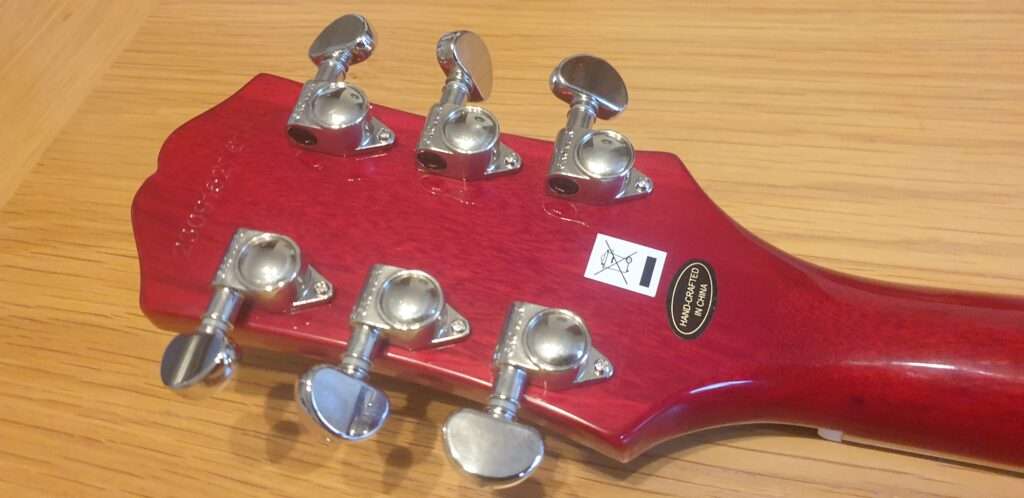
Having the higher output Probucker 2 & 3 pickups are a good balance, giving you more grunt than the probucker 1 & 2 of the Standard 50s, but are not as gainy and modern sounding as the Alnico Classic PRO™ humbuckers™ of the Studio and Classic.
Although this guitar doesn’t have the switching options of the Studio and Classic, it feels more like the full-blooded, traditional Les Paul I was looking for. I don’t need it to be a Strat as I already have one of those.
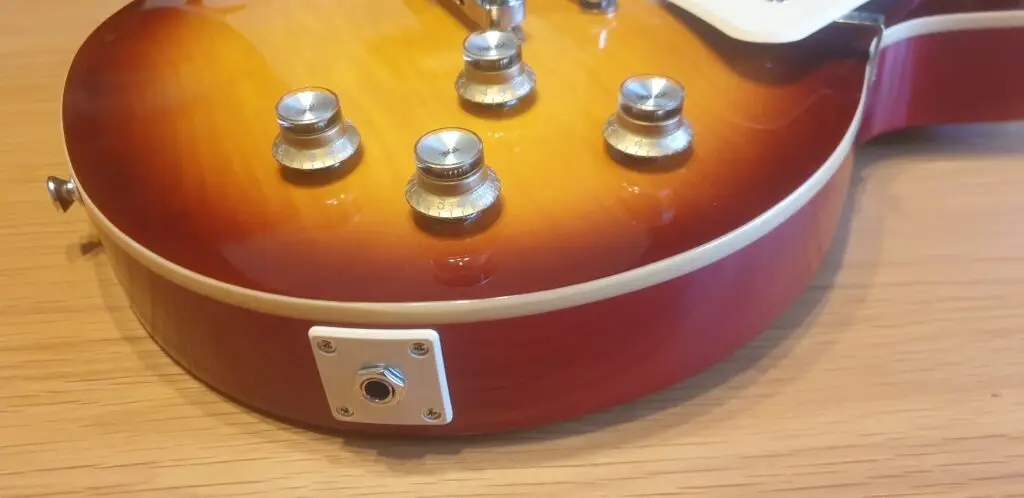
Looks
Well, just look at it!

Yes, I know this isn’t the real thing (see below), but I always wanted a sunburst Les Paul and I’m more than happy with this Iced tea sunburst veneer. This shouts just as loud as the PRS in my opinion.
Let’s also give a shout out to the new ‘Inspired by Gibson’ headstock which, although still not perfect, is a huge improvement on the previous design.
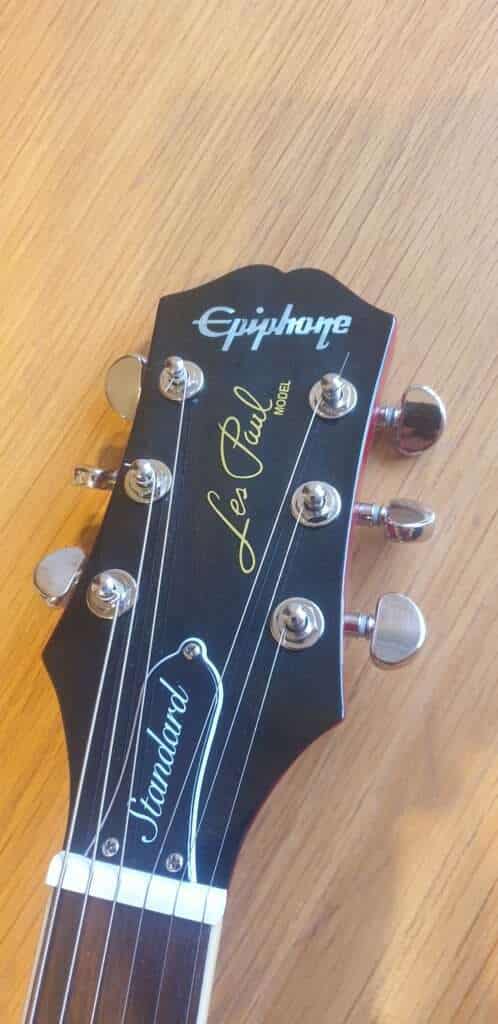
Build Quality and concessions to a Gibson Les Paul Standard
You can’t expect a £500 guitar use the same materials and construction as a Gibson, so to begin with here are the differences:
- Veneered back vs solid mahogany back on the Gibson

- Maple cap and maple veneer vs just the maple cap of the Gibson.
- Three-piece neck (scarf jointed at the neck and heel) vs one piece neck of the Gibson
- 14″ vs 17″ headstock break angle.
- polyurethane vs Nitrocellulose finish.
- Chinese vs USA build.
- ProBuckers vs USA Burstbucker pickups.
- Other assumed differences may be better quality woods, hardware, electronics and more attention to detail with the finishing and setup.
With that out of the way, let’s focus on the Epiphone, which is around a quarter of the price of the Gibson, and which actually has a few tricks up it’s sleave in it’s favour.
- The Graphtech nut, which is perfectly cut and auto-lubricated.
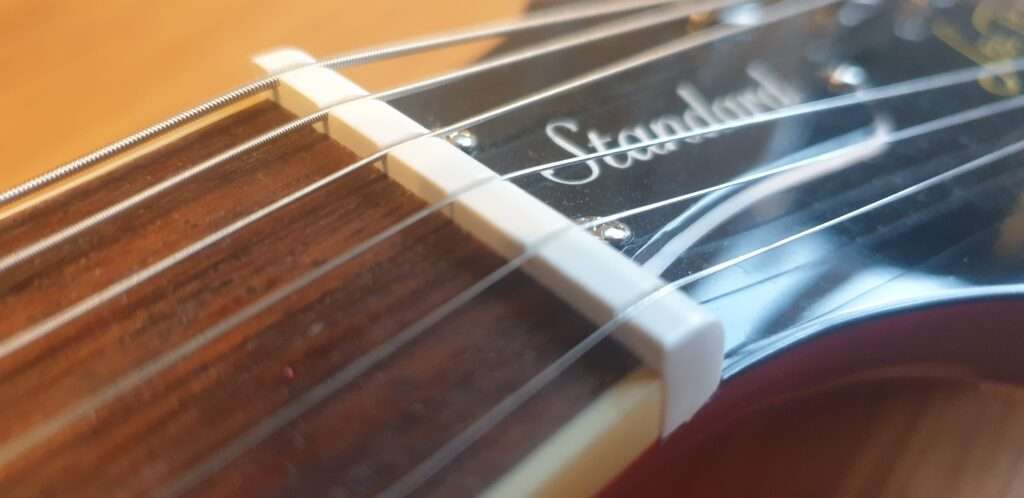
- The LockTone hardware, which won’t fall off when you change strings.
- The long tenon neck joint which you’ll only get in the Gibson custom shop.
- ‘Plug’ style pickup connects vs soldered, making pickup upgrades much easier.
- The harder-wearing finish which will last forever and not deteriorate within a week.
Above all, every single component has been put together flawlessly and the finishing is emmaculate, which you can’t always say about Gibson guitars lately. The Epiphone Les Paul 60s Standard is build like a tank, just like any Les Paul should.
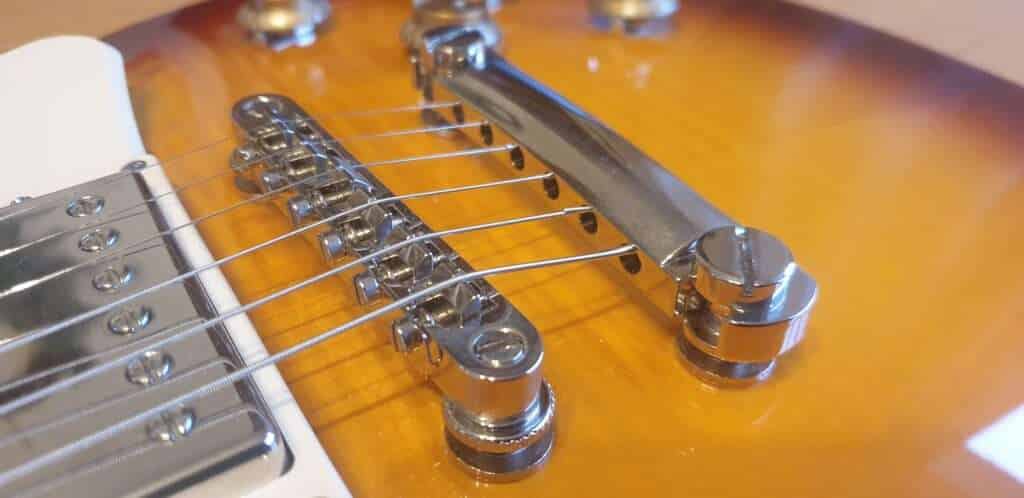
Playability
With the original 10s it has to be said string bending felt a little stiff, particularly compared to the slinkiness of my Strat, but a string change down to 9s transforms this guitar into one of the most effortless players out there. Action is around the 1mm mark at the 12th fret or even lower if you dare, but don’t take my word for it here’s the proof.

For all it’s heft, the Epiphone Les Paul Standard 60s, with that slim taper neck, nicely installed frets and low action can play a chord if you so much as breath on it, and soloing right up the the highest registered isn’t as unhindered much as I remember, in fact, as a solo instrument, it’s not suprising why it’s still the go-to guitar of choice for many.
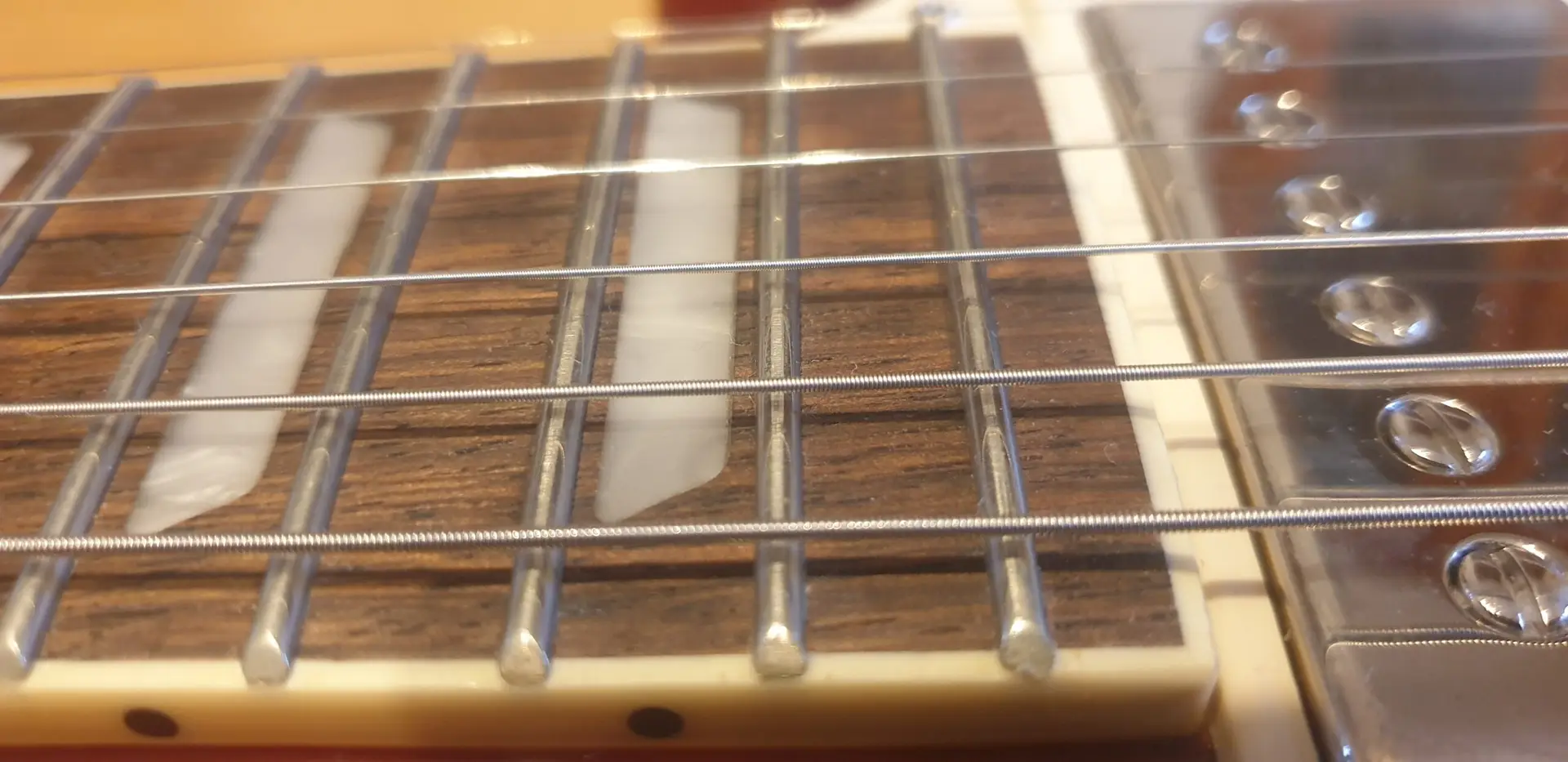
Make no mistake, just like my first experience with the Studio version, this really does feel like a real Gibson Les Paul.
As a bonus, and as is the norm for modern Epiphones, tuning stability is as predictably dependable as it gets, with the combination of a fixed bridge, slippery, well-cut nut and quality machine heads giving zero opportunity for tuning issue to creep in. These guitars just don’t go out of tune!
Tones
The best place to start is to check out the tones for yourself in my video review:
There’s nothing much really to add, but just to re-iterate the ProBucker 2 & 3 really is a great combination. The neck (the lower output ProBucker 2) handles clean and low gain better than you’d have imagined, and better than any Les Paul i’ve played, Gibson or otherwise, with the bridge being out of sorts until more overdrive comes into the equation, at which point it takes over! In summary this non-switching, twin humbucker guitar is much more versatile than it first appears, and it achieves this in such an organic, fun way between various levels of gain across it’s pickup configurations.
Of course, Les Pauls, with their control layout of dedicated tone and volume for each pickup open up a whole world of tone sculpting exploration. Check out the outtro rythmn track and solo on my new Christmas song, which features this very guitar.
I’m going to say this is the best-sounding Les Paul I’ve ever played, and that goes for Gibsons, Epiphones and everything else. From rare clarity on the neck position with a clean tone through to massive sounding overdriven rythmn and singing full-blown fruity or biting solos depending on pickup selection. It’s all there, and it sounds much more expensive than what it is, with a perfect balance between biting top-end, punchy mids and warm smoothness when you need them.
It’s true, you’ll never achieve those pristine, hollow, out of phase strat tones we all know and love for a whole manner of clean or funky stuff, even in the middle position, but that’s what the strat is for, and not the job of this guitar.
Value for Money
The Epiphone Les Paul Standard 60s doesn’t represent the best value for money, even in the ‘Inspired by Gibson’ Les Paul range. That honour goes to the Epiphone Les Paul Studio which has a street price of £349 compared to £500 for this Standard 60s, which is well over a 40% increase. This uptick becomes even more absurd if you were to look at the Custom.
Ultimately, for players looking for a Les Paul, or someone starting out on their journey, I can’t recommend the Studio enough, but personally, I was happy to pay a little more than I’m comfortable with for the exact features and look I wanted, in the knowlege that, while on the expensive side, £500 still gets me a lot of guitar for my money. I would’ve been a lot happier paying £399 for this, which is what Epiphone Les Paul Standards historically retailed for, but hey, times have changed and so has the quality, for the better. My only gripe is that Epiphone’s price scaling seems far too steep as you go up the food chain and it doesn’t really need to be for a Chinese-made guitar.
Conclusion.
Something that’s not easy to quantify is how much I love this guitar. I’ve already (hopefully) described how it looks great, sounds great, and plays great, but there’s something more here. As I said earlier, this year was a special one for me and I wanted to celebrate a milestone with a special guitar acquistion (although these days £500 is my limit). I spend months thinking about it and researching my next move, coming to the conclusion that it had to be a return to the Les Paul theme, having owned and spent countless hours with them previously in bands and other ventures.
I’d come to the end of my journey and struggle with Strats for now, having finally settled on my Fender Player Strat with it’s Squier neck after months of painful fixes and tweaking of these notoriously fiddly and temporamental guitars. I will always love Strats, bus as soon as I was dealing with Les Pauls again, and in particular this Les Paul, my troubles were behind me and I really could have the best of both worlds for the first time. Yes, it’s expensive for a Chinese made guitar, but this isn’t just a box-ticking exercise (although the boxes are well and truly ticked). No, this guitar is more than it’s quality parts and construction. As soon as those 9s went on it, as soon as I hit record on my Christmas song, everything was there. All I need to do with this guitar is sort of ‘suggest’ things and it goes off and delivers, there’s no fightback or hindrance whatsoever in the fingers to the strings to the pickups to the tone coming back to your ears. It gives your playing confidence, It’s huge, thick and sweet. It reminded me of how great guitars can sound, especially overdriven. Yes. I really can do this.

But the best thing? The complete lack of fuss. No setup, no issues, and no dramas, for the whole of it’s six-month lifetime, and that’s meant quality time making music rather than chasing my tail. You can’t buy that…
… but you can support my blog by purchasing an Epiphone Les Paul 60s Standard @ Guitar Center via my affiliate link here.
Thank you.




Hi Adam!
I can recognize all of your thoughts in the review.
Since I got my Epiphone Les Paul Standard 60 (Bourbon burst 2011) my Fender Strat has been laying in its case. There is nothing (apart from the Gibson logo) that I miss with this guitar. It’s got everything I want, the looks, the feel, the sound…
Best thing was that I swapped it for 4 hockey goalie sticks. 🙂
I need to sell my Fender Strat though. It should be played, but not by me.
/Joa
(Sorry for the poor language. I’m Swedish)
Hi Joa. Thanks for visiting the blog and that was perfect English! Yes I’ve had no issues at all with the. Epiphone. Looks great, plays great, and no fiddling about or dramas like my strat. Glad you’re enjoying yours.
Hi Adam, great article.
I must agree with you the 60 series Les Paul is incredible. I purchased one, a smokehouse burst from Sweetwater sound in June. I’ve played Strats for the last 30 years, I wish I would’ve purchased this 25 years ago.
The biggest thing that blew me away about this guitar beyond its looks and workmanship was the tone I could get out of it. Tones I just can’t get out of my 96 American standard Stratocaster. Very satisfied with this guitar.
Hi William
Thanks for stopping by. Sounds like I’m not the only fan of them!
A few weeks ago I foolishly thought of selling this guitar, maybe a bit of a vanilla cookie cutter? Maybe lacking on personality?. As soon as I started recording with it I knew I was wrong!
I’m keeping this.
Hi, I have had an Epiphone Inspired by Gibson 1960’s Maple Fade Les Paul Standard that was made in Canada since 2022 when I bought it in Edmonton, Alberta, Canada on a trip for $780 CDN. Now 2 years later, my LP costs $1100. To find it, I played over 20 Epiphone Les Paul types. Buying the Epiphone standard is a good investment, plus the sound rivals the Gibson.
Hi Brigitte
I Agree they feel really close to a Gibson now, especially the neck and the tone has seen a big improvement in recent years.
Your guitar sounds fantastic i don’t think us or many others need to bother with Gibson anymore 😀